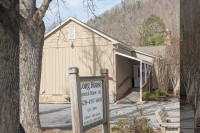Trumpet vine is tenacious and beautiful
 It’s mid-June again … the time of the year when certain plants can be relied upon to do their thing in our yard and on the decks that enclose the house on three sides. Yuccas, oak-leaf hydrangeas, spiderworts, coral vines, various ornamental lilies and roses, and others are in full bloom. But none of these can hold a candle to the trumpet vine.
It’s mid-June again … the time of the year when certain plants can be relied upon to do their thing in our yard and on the decks that enclose the house on three sides. Yuccas, oak-leaf hydrangeas, spiderworts, coral vines, various ornamental lilies and roses, and others are in full bloom. But none of these can hold a candle to the trumpet vine.
In the wild, along fencerows or in lightly shaded woods, trumpet vine is simply stunning. Its four-to-six inch tubular flowers are exhibited high and wide for all to see and admire on the outstretched tips of numerous horizontally extended shoots. Climbing as high as 30 feet, it dominates the immediate landscape with its shiny-green intertwined foliage and reddish-orange flowers.
That’s the good news. The negatives regarding trumpet vine (sometimes called cow-itch vine) as an ornamental plant are recorded in virtually every gardening book, where it is inevitably described as “invasive” or “rampant.”
One otherwise positive account warns, in passing, that, “The tendrils cling so tightly they can damage roofs and masonry.” Another recommends “this viney weed” as being “suitable for decorating chicken houses.” And then there’s the fact that some people, after handling the leaves, break into a rash, sometimes with small blisters, with one or both symptoms lasting for three or four days.
Nevertheless, I love trumpet vine (Campsis radicans) and advocate its use as an ornamental; that is, of course, so long as you’re one of those who can handle the plant without breaking out in a rash.
In the spring of 2002, I built four 10-foot high trellises on our deck. Two of them serve as arched entranceways where steps leading up to the deck are situated. My wife already had some sizeable trumpet vine seedlings in the garden, so I simply transplanted several to the base of each trellis.
Related Items
Trumpet vine doesn’t need any encouragement when it comes to climbing. They are natural born climbers that ascend via aerial rootlets growing directly out of newer shoots at the leaf nodes. These rootlets are very tenacious and are the reason you don’t want the plant to climb on any surface that might be damaged. But I don’t really care how much they penetrate the pressure-treated wood of my trellises. I may have to replace the trellises at some point in time, but that’s no big deal.
If allowed to fruit and distribute seeds via the numerous pods that accumulate during a growing season, trumpet vine could literally take over a yard or pasture. To prevent this gather and destroy the pods before they open in late fall. Don’t harvest them immediately, however, because the long graceful pods are almost as attractive as the flowers.
As might be expected, ruby-throated hummingbirds are attracted by the red flowers. In Europe the plant is known as hummingbird vine. The pollen-producing male anthers are situated along the top of the floral tube. The pollen-receiving female pistil is also situated along the top of the tube, but it extends farther toward the corolla opening than the anthers.
As the hummer initially pokes its head into the opening, any pollen deposited on its head by another trumpet vine flower is transferred to the pistil. Then, as the hummer moves farther into the flower seeking nectar, its head is covered with new pollen that it transfers to yet another flower. Thereby, in return for the nectar and energy, the hummer helps the plant accomplish cross-fertilization in a very nice symbiotic relationship.
(George Ellison is a naturalist and writer. He can be reached at This email address is being protected from spambots. You need JavaScript enabled to view it..)









